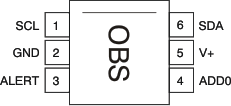SBOS473J March 2009 – February 2024 TMP112
PRODUCTION DATA
- 1
- 1 Features
- 2 Applications
- 3 Description
- 4 Device Comparison
- 5 Pin Configuration and Functions
- 6 Specifications
-
7 Detailed Description
- 7.1 Overview
- 7.2 Functional Block Diagrams
- 7.3 Feature Description
- 7.4 Device Functional Modes
- 7.5 Programming
- 8 Application and Implementation
- 9 Device and Documentation Support
- 10Revision History
- 11Mechanical, Packaging, and Orderable Information
Package Options
Mechanical Data (Package|Pins)
Thermal pad, mechanical data (Package|Pins)
Orderable Information
5 Pin Configuration and Functions
DPW Package
5-Pin X2SON
TMP112D
(Top View)
5-Pin X2SON
TMP112D
(Top View)
 DRL Package
DRL Package6-Pin SOT563
(Top View)
DPW Package
5-Pin X2SON
TMP112D0/D1/D2/D3
(Top View)
5-Pin X2SON
TMP112D0/D1/D2/D3
(Top View)
Table 5-1 Pin Function
| PIN | Type(1) | DESCRIPTION | |||
|---|---|---|---|---|---|
| NAME | NO. TMP112A/B/N | NO. TMP112D | NO. TMP112D0/1/2/3 | ||
| SCL | 1 | 2 | 2 | I | Serial clock |
| GND | 2 | 1 | 1 | — | Ground Pin-1 has curved edges in TMP112Dx. |
| ALERT | 3 | - | 3 | O | Overtemperature alert. Open-drain output;
requires a pullup resistor. Note: Connecting to GND if Alert pin is not used is preferred. |
| ADD0 | 4 | 3 | - | I | Address Select. Connect to V+, GND, SDA or SCL |
| V+ | 5 | 5 | 5 | I | Supply voltage, 1.4 V to 3.6 V |
| SDA | 6 | 4 | 4 | I/O | Serial data. Open-drain output; requires a pullup resistor. |
(1) I = Input; O = Output, I/O = Input or Output